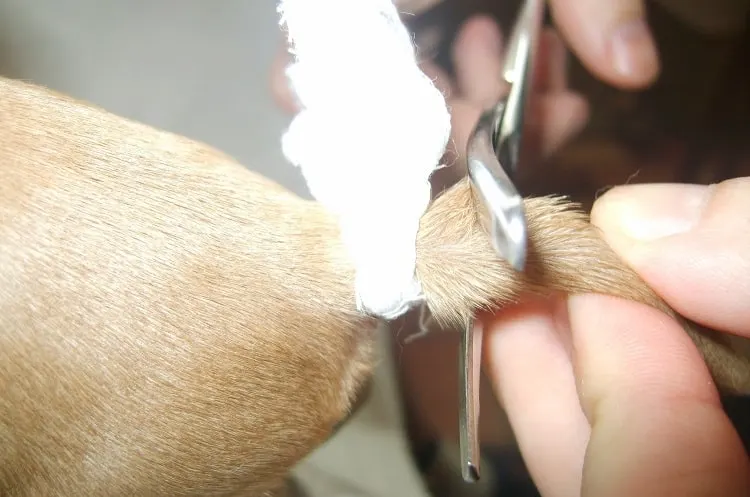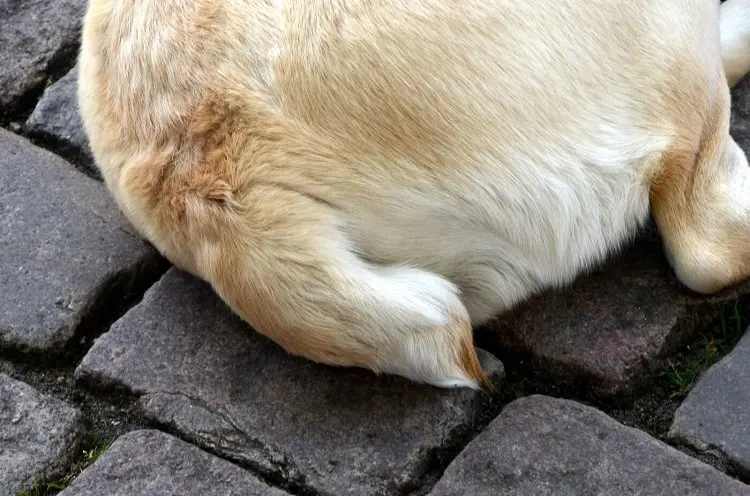Why Do Australian Shepherds Have Docked Tails?
Australian Shepherd owners often get their dogs’ tails docked. Why? To compete in dog shows, for aesthetic purposes, or because a shorter tail is also more hygienic.
Some Australian Shepherds, however, are born without a tail (roughly one in five). So, what exactly is tail docking, and should you do it to your Aussie?
The following article will go over facts and essential information regarding tail docking to help you make an educated decision.
Just like everything else in life, there are pros and cons, and it’s your responsibility as a dog owner to familiarize yourself with both sides of the coin. Let’s get started.
What Is Tail Docking?

Tail docking, also known as caudectomy, is the procedure of cutting off part of an animal’s tail.
It is most commonly performed on dogs, but it can also be done on other animals such as cows, pigs, and sheep.
An animal with a bobbed tail is not a result of poor breeding, but rather it’s done for practical reasons.
The extent of the docking will vary depending on the reason for the procedure, but it typically involves removing around one-third to one-half of the natural tail length.
The procedure is usually carried out when the Australian Shepherd puppy is about three to five days old, when they may not experience too much pain, since experts believe that during these early days, the puppy’s nervous system is not yet fully developed.
In the case of older dogs, docking is possible but will be treated as a standard surgical procedure.
After surgery, adult dogs must be given anesthesia and postoperative care, including pain medication and antibiotics.
History of Tail Docking

The practice of tail docking in dogs has a long history, dating back to at least the Roman Empire.
In ancient times, dog tails were often docked to prevent rabies, as it was believed that the virus could be spread through a tail. The procedure was also thought to avoid injuries during hunting and fighting.
In the past, people believed that a dog with a short tail could run faster. Dogs were frequently used in hunting, so the docking process was credited with providing them with greater speed.
Today, docking is most commonly seen in certain breeds of dogs, such as Boxers, Dobermans, Australian Shepherds, and Rottweilers.
Tail docking has been done primarily for aesthetic reasons, particularly in certain breeds of dogs where it is considered standard practice.
In some cases, it is still done for practical purposes, such as preventing injuries in hunting or for working dogs.
Some breeders believe that a bobbed tail gives the dog a more streamlined appearance, while others believe it makes the dog look more aggressive.
However, there is no scientific evidence to prove either of these claims.
Is Tail Docking Legal?

There are a variety of opinions on docking, with some countries banning the practice outright and others taking a more relaxed stance. In general, it is legal to dock tails in many countries worldwide.
The United Kingdom is one example of a country where the docking procedure is legal, although some restrictions exist.
Part of their guidelines is that the medical professional must be properly trained to carry out the procedure, and dog owners must have a good reason for wanting their dog’s tail docked.
Other countries, such as Australia and New Zealand, have also legalized docking. However, there are again certain restrictions in place.
For example, in Australia, tail docking can only be performed by a registered veterinarian and must be done for therapeutic reasons.
In recent years, there has been growing opposition to the procedure, and several countries have passed laws banning the practice.
Other countries that consider it illegal are: Switzerland, Norway, Sweden, Chile, Austria, Italy, Colombia, Belgium, Italy, and Greece.
Meanwhile, in the United States, docking is not currently regulated at the federal level. Individual states are free to make laws on the matter, and therefore, it is legal in some states but not in others.
Overall, the legality of docking varies from country to country. In many cases, it is legal, although certain restrictions exist. It is always best to check your country’s laws before docking your pet’s tail.
Tail Docking – Pros

There are several reasons why an owner might choose to dock their dog’s tail. Here are three of the most common benefits of of tail docking.
Docking Can Help to Prevent Injuries
Dogs with their tails docked are less likely to suffer from injuries to the tail itself, especially in miniature breeds.
Dogs that are particularly active or live in homes with small children may be at a higher risk for tail injuries, so docking their tails can help keep them safe.
Some breeds have flowing, long tails and are often prone to catching in doors or other objects, which can lead to serious tail injury. Docking the natural tail can help to prevent these types of accidents.
Tail Docking Gives Better Hygiene and Cleanliness
One area that is often overlooked is the tail. While most dogs naturally keep their tails clean, some breeds are more prone to dirt and debris buildup. For dogs, docking can be an effective way to ensure better hygiene and cleanliness.
Removing the hairless tip of the tail allows less surface area for dirt and debris to accumulate. In addition, docking can help to prevent odors from developing.
Tail Docking Can Be Aesthetically Pleasing
Some people prefer the look of a dog with a shortened tail. Cosmetic tail docking is entirely a matter of personal preference.
Docking a puppy’s tail is a personal decision that should be made based on your circumstances and preferences.
However, it is essential to remember that this procedure does have some risks and should only be performed by a qualified veterinarian.
Tail Docking – Cons

While some people believe that docking is beneficial and necessary for certain dog breeds, others believe that it is cruel and unnecessary. Here are four drawbacks of having an Australian Shepherd’s tail docked.
It Can Be Painful for the Dog
While some dogs may not feel pain when their tails are docked, others may experience significant discomfort.
The process involves cutting through skin, muscle, and bone. In addition, puppies who have their tails docked may also suffer from infections or other complications.
It Can Interfere With the Dog’s Ability to Communicate
One potential downside of docking is that it can interfere with the dog’s communication ability. When a dog wags its tail, it conveys important information about its emotional state.
For example, an Aussie’s tail that wags slowly may indicate relaxation, while a rapid wag may indicate excitement or happiness.
By removing the tail, we are depriving the dog of an essential means of communication. In some cases, this can lead to misunderstandings and even aggression.
It Can Result in Incontinence
The nerves in charge of sending out signals to the brain that tell the dog when it has to defecate or urinate are cut.
It then prevents the dog from being able to tell when it has to go and results in the dog going whenever and wherever.
It can be highly frustrating for the dog and the owner, who must constantly clean up after their pet.
Are There Australian Shepherds Born Without Tails?

According to the Australian Shepherd Health & Genetics Institute (ASHGI), one out of five Australian Shepherds will have a naturally bobbed tail.
In most cases, Australian Shepherds born with naturally bobbed tails result from a genetic mutation. This mutation can occur spontaneously or be passed down through generations of Australian Shepherds.
However, it is important to note that not all Australian Shepherds with natural bobtails will have the same appearance.
Some Australian Shepherds have only partially docked tails, while others may have a full-sized tail length that simply curls under at the tip.
While an Aussie with a natural bobtail is not as common as those with an undocked tail, they are still recognized by the American Kennel Club (AKC).
Regardless of their exact appearance, all these dogs share one thing in common: they are true Australian Shepherds, just like their long-tailed counterparts.
Also read: Everything You Need to Know About the Short-Haired Australian Shepherd
How Long Does a Dog’s Docked Tail Take To Heal?
The tail docking procedure is typically quick and relatively simple, and recovery times are short.
Most animals will heal completely within three to seven days, although some may experience some soreness or discomfort for a brief period.
More severe complications, such as infection or nerve damage, can occur in rare cases.
Conclusion
The practice of tail docking in Australian Shepherds is a controversial one. Some believe it is necessary for the breed, while others find it cruel and unnecessary.
Like most things in life, the answer is somewhere in the middle. While there are certainly some drawbacks to docking tails, there are also many benefits.
Ultimately, it’s up to each dog owner to decide whether or not their dog should have its tail docked.
Resources:




















